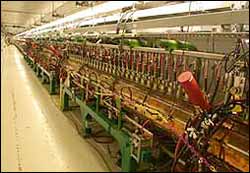This area deals with the fundamental laws and building blocks of nature and how they interact, the properties and the behavior of matter, and research into space and time and their structures.
innovations-report provides in-depth reports and articles on subjects such as astrophysics, laser technologies, nuclear, quantum, particle and solid-state physics, nanotechnologies, planetary research and findings (Mars, Venus) and developments related to the Hubble Telescope.

A dedicated team of scientists is spending the next four weeks in northern Chile’s Atacama Desert. They are studying the scarce life that exists there and, in the process, helping NASA learn more about how primitive life forms could exist on Mars.
The NASA-funded researchers are studying the Atacama Desert, described as the most arid region on Earth, to understand the desert as a habitat that represents one of the limits of life on Earth. The project, part of NASA’s Astrobiology

Silicon microelectronics has undergone relentless miniaturization during the past 30 years, leading to dramatic improvements in computational capacity and speed. But the end of that road is fast approaching, and scientists and engineers have been investigating another promising avenue: using individual molecules as functional electronic devices.
Now a team of engineers at Northwestern University has become the first to precisely align multiple types of molecules on a silicon surface a

Physicists at Imperial College London are developing a new optical disk with so much storage capacity that every episode of The Simpsons made could fit on just one.
Speaking at the Asia-Pacific Data Storage Conference 2004 in Taiwan today, Dr Peter Török, Lecturer in Photonics in the Department of Physics, will describe a new method for potentially encoding and storing up to one Terabyte (1,000 Gigabytes) of data, or 472 hours of film, on one optical disk the size of a CD or DVD

With the recent “warm commissioning” of its linear accelerator, Oak Ridge National Laboratory’s Spallation Neutron Source (SNS) has passed a crucial test and milestone on its way to completion in 2006.
The SNS’s linear accelerator, or linac, is composed of two sections: the “warm,” or room temperature section, and a superconducting section that operates at temperatures hundreds of degrees below zero. Los Alamos National Laboratory, part of the team of six DOE national laboratories

Since it started orbiting Saturn last June, the Cassini mission has returned incredible images of the gas giant, its dazzling rings and its enigmatic moons. But its most dramatic chapter will come this January, when a European lander probe (Huygens) that has been piggybacking on Cassini for the last seven years is sent on a fiery plunge into the murky atmosphere of Saturn’s largest and most mysterious moon, Titan–a chapter that would have ended in disaster, save for an engineer called Boris Sm

The recently released Hubble Space Telescope Ultra Deep Field (HUDF) – the most sensitive image of the distant universe ever obtained – has provided UK astronomers with a window on star formation when the universe was young, revealing some of the earliest star forming galaxies yet detected.
The research was led by Dr Andrew Bunker at the University of Exeter and graduate student Elizabeth Stanway at the Institute of Astronomy at Cambridge University. Their results have been accepted